Mission Report: See It Big in 70mm |
Read more at in70mm.com The 70mm Newsletter |
| Written and photographed by: Howard B. Haas, Philadelphia, USA. All photos by author, except when noted. | Date: 05.09.2017 |
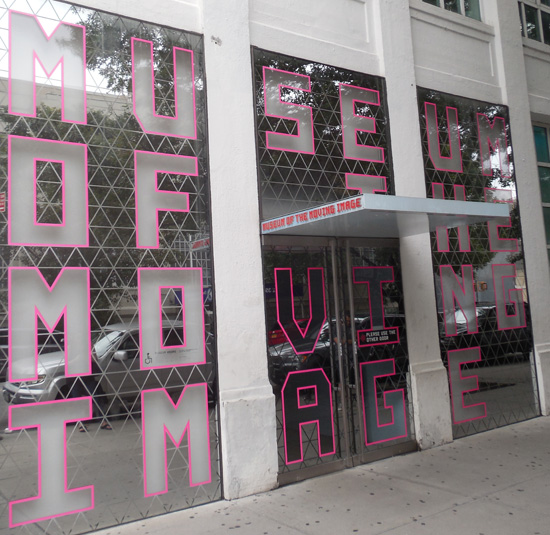 A year ago, my article was published here
about my first visit to the Museum of the Moving Image in the Astoria
neighborhood of Queens, New York City, for last year's 70mm festival, in the
Redstone Auditorium. A year ago, my article was published here
about my first visit to the Museum of the Moving Image in the Astoria
neighborhood of Queens, New York City, for last year's 70mm festival, in the
Redstone Auditorium.This year's 70mm festival began Wednesday evening, July 19 with an advance “Preview Screening” of “Dunkirk” in 70mm. Despite a higher price, the preview sold out. I saw “Dunkirk” on Saturday July 22, at Philadelphia's Franklin Institute IMAX dome in a 70mm IMAX screening that also sold out. Two of my photos of “Dunkirk” film reels and film cans in the projection booth were included at the "Dunkirk" Production Notes“Dunkirk Production Notes” article on this website. Filmed three fourths with 65mm IMAX cameras and one fourth in 65mm Panavision System 65, “Dunkirk” is an incredible experience to see. I met two young fellows who had never seen 70mm film, who drove from Pittsburgh and stayed overnight to see it in 70mm IMAX. At the Museum of Moving Image, “Dunkirk” was followed by screenings of “2OO1: A Space Odyssey” on Thursday and Friday evenings August 3 and 4, Saturday afternoon August 5, and two more shows on Sunday August 6. The 70mm screenings of “2OO1” usually sell out at the Museum. This year's screenings were about half full, likely because they've been so generous in having so many screenings. “2OO1” of course, is one of the most popular 70mm films anywhere, so popular that this year Chicago's Music Box Theatre purchased their own 70mm print. Seattle's Cinerama Theater also owns a 70mm print, which I saw there in 2013 as well having seen a new 70mm print at the Uptown Theater in Washington DC in the year 2001. |
More in 70mm reading: "SEE IT BIG!" 2017 70MM Series @ Museum of the Moving Image, New York, USA See it Big! The 2016 7Omm Show Review Internet link: |
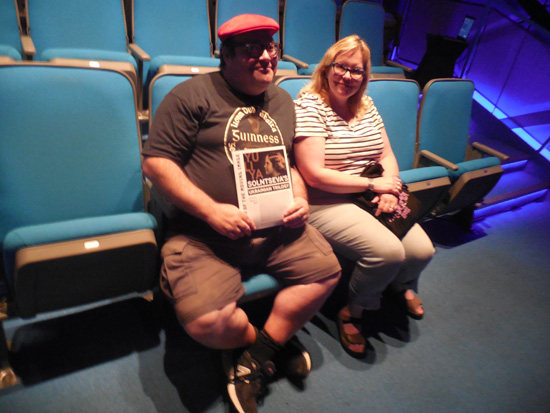 Jordan
Hoffman and wife Anne Farrell. Jordan
Hoffman and wife Anne Farrell.My first journey here this year was for the 2 PM show of “Lawrence of Arabia” on Saturday August 12. I took Septa and NJ Transit trains from Philadelphia to New York's Penn Station and walked a short distance to 34th St Herald Square Station. Last year, I then took the “N” line but as a shuttle bus was substituting for part of its journey, I took the “R” line, which like the “N” line only takes about 20 minutes. This time I arrived at Steinway Station, named for a world famous piano company that has been making pianos for more than 160 years and is located in Astoria. I asked directions of a couple, and along with the directions to the museum, the man replied they have been members of the museum for 25 years! I am not old enough to have seen “Lawrence” in its original issue. I saw it for the first time on the big screen in 1989 at the single screen Uptown Theatre in Washington D.C. Previously a neighborhood theater, from 1956 the Uptown has been a showplace for all large format screenings including 70mm and during the original era, Cinerama, and retains a huge curved screen that is more than 70 feet wide. Film restorer Robert Harris, with the cooperation of director David Lean, had lavishly restored “Lawrence” for the 1989 release, adding back long gone footage, and even assembling the film's still living stars to replace missing dialogue. The 1989 screening knocked my socks off. That was the first movie filmed in 65mm that I saw presented in exquisite 70mm, and my first “roadshow” screening including full use of the movie curtain and the music before and after the film, and at intermission. The line was around the block, the movie sold out the 1120 seats and “Lawrence” became my favorite movie ever, and stayed my favorite movie for many years. |
|
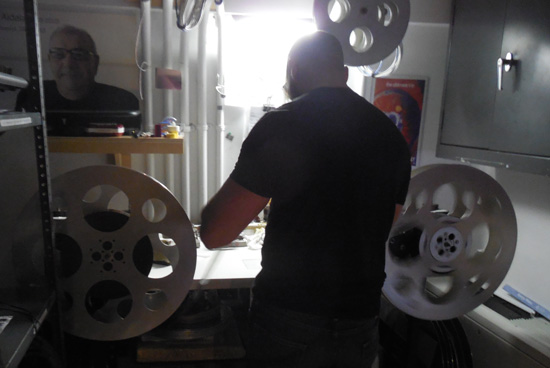 In 2002, for the 40th Anniversary of
“Lawrence” Robert Harris further
restored the movie, including color corrections. In 2013 at the Seattle
Cinerama, I enjoyed that version. For the 50th Anniversary of “Lawrence” in
2012, the 1989 restoration was scanned and then lavishly further restored. I
saw the resulting 4k digital version in 2013 at the historic Ambler Theatre
in the Philadelphia suburbs. The Ambler's red curtain is seldom used, but
“Lawrence” is such a epic movie, the Ambler used the curtain to open the
movie. In 2002, for the 40th Anniversary of
“Lawrence” Robert Harris further
restored the movie, including color corrections. In 2013 at the Seattle
Cinerama, I enjoyed that version. For the 50th Anniversary of “Lawrence” in
2012, the 1989 restoration was scanned and then lavishly further restored. I
saw the resulting 4k digital version in 2013 at the historic Ambler Theatre
in the Philadelphia suburbs. The Ambler's red curtain is seldom used, but
“Lawrence” is such a epic movie, the Ambler used the curtain to open the
movie. A new 70mm print of “Lawrence” was supplied by Sony Pictures Repertory to the Museum of the Moving Image. I asked Park Circus, which is also proudly distributing the movie, including to London's BFI this September, as to the genesis of the 55th Anniversary new prints. Park Circus replied that the new print is from the 2012 restoration for the film's 50th Anniversary. Film writer Lincoln Spector recently wrote that Sony's Vice President, Grover Crisp, emailed him that for the 2012 restoration, a new 65mm negative of the film was made. The museum's chief projectionist, Fred Baez, showed me the film cans and replied to my question regarding the audio, that the Museum was showing it in 70mm 6 track. So far as I know, the museum is the first exhibitor anywhere of this new print. |
|
 "The
Enchanted Desna" film cans "The
Enchanted Desna" film cansThe new print of “Lawrence” was sold out and as always at the museum, the presentation had all the bells & whistles. The curtain stayed closed for the overture music. The curtain closed at intermission, then music resumed before the curtain opened again. At the film's conclusion, the curtain closed, with the exit music continuing. Visually, this 70mm new print was astonishingly beautiful. The sharp 70mm resolution and the 70mm details were stunning. The restored colors were truly vibrant. The awesome 1989 restoration had looked good, with a beige colored dessert, but that same desert was often glowing in orange now in this restoration. Every frame of the movie popped in glorious color and detail. The sound was excellent. Surround sound was strong, from the “echo chamber” in the mountain valley to battle scenes. This screening of this epic film was exhilarating. The audience gasped, and at the conclusion, they applauded. Back at Steinway Station, I heard someone refer to “In the Dessert!” and I knew how he had spent his afternoon. There were three more screenings of “Lawrence of Arabia” which did very well. Box Office staff told me that the next titles shown, “Patton” “Pink Floyd: The Wall” and “Interstellar” sold anywhere from 100 tickets to half the auditorium. “The Dark Crystal” reportedly filled more than half the auditorium. During the festival, “The Right Stuff” was added, and the auditorium was again reportedly about half full. The next films I attended were on Saturday, August 26, the “Ukrainian Trilogy” by director Yuliya Solntseva. These rarely shown films were shipped from Russia by Gosfilmofond for these screenings. Until this day, the only movies that I had seen that were filmed in 65mm had been filmed in English, but today I was in for a special experience. As the movies arrived without subtitles, a woman named Anna in the auditoriums diligently translated live the movies from Russian on a laptop, which resulted in subtitles being placed on the screen. I've experienced pipe organists who improvise without their having previously seen a silent movie, but had not seen “live” subtitling! All three films have a fantastical spin to them, as well as many flashbacks, but regardless of not having conventional plot structures, were very worthwhile on the big screen. These films can all be characterized as propaganda in a pro Soviet way and from a Ukrainian perspective. Each had scenes depicting World War Two and the battles and struggles against the Nazi German invaders. |
|
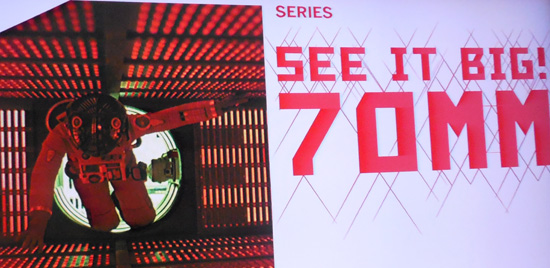 Solntseva directed these Soviet avant garde films after the death of her
husband, legendary Ukrainian filmmaker Alexander Dovzhenko, who wrote the
screenplays but suffered a fatal heart attack the night before filming was
to begin on the first film, “Poem of an Island Sea” (1958, scope). “Poem”
was shown in 35mm in the 68 seat, raked, Celeste and Armand Bartos Screening
Room, on the 16.6' x 9.4' screen. The 2 PM screening sold out! The movie
about a Ukrainian village that is to be submerged underwater for a power
plant, is an example of “magical realism.” The projectionist told me that
sound was mono and optical. The movie run time was stated to be at 95
minutes but to everybody's surprise, ran several minutes longer, not
including when the print broke near the end, but was repaired and the
screening resumed. The color print was enjoyable as the story was rich in
its characterizations of the villagers and in its splendid filming. Solntseva directed these Soviet avant garde films after the death of her
husband, legendary Ukrainian filmmaker Alexander Dovzhenko, who wrote the
screenplays but suffered a fatal heart attack the night before filming was
to begin on the first film, “Poem of an Island Sea” (1958, scope). “Poem”
was shown in 35mm in the 68 seat, raked, Celeste and Armand Bartos Screening
Room, on the 16.6' x 9.4' screen. The 2 PM screening sold out! The movie
about a Ukrainian village that is to be submerged underwater for a power
plant, is an example of “magical realism.” The projectionist told me that
sound was mono and optical. The movie run time was stated to be at 95
minutes but to everybody's surprise, ran several minutes longer, not
including when the print broke near the end, but was repaired and the
screening resumed. The color print was enjoyable as the story was rich in
its characterizations of the villagers and in its splendid filming. The next film from the trilogy, “The Story of the Flaming Years” (1961, 2.20 aspect ratio, 91 minutes) was shown at 4:30 PM that Saturday. More than half the seats were filled in the Redstone Auditorium. “Flaming Years” is a sweeping World War Two epic. As with all films of this trilogy, there are flashbacks and the film is “poetic” but there is also much WW2 drama including scenes depicting fierce battles. The 70 mm print was in excellent condition. The cinematography was outstanding. The sound, which I was told was magnetic, was likely 6 track. It was booming loud, with surround sound of voices and effects on the side walls, and under out feet, bass sound was felt. The theater curtain was used, as it normally is, to open and close this film and the movie that followed. For “Flaming Years” the director won Best Director at the Cannes Film Festival, the first and only time for a female director until Sofia Coppola won this year for “The Beguiled.” Before “Flaming” I spotted a happy looking couple in the audience, close to the uppermost seating in the auditorium, and asked if they would be willing to be interviewed for this article. Jordan Hoffman has his own Wikipedia entry, and writes in the film industry. He was accompanied by wife Anne Farrell. Last year, at the museum's 70 mm festival, they enjoyed “2OO1: A Space Odyssey” which they stated looked better on the movie screen than the DCP version of the movie they saw in another theater. Today, while I had been watching “Poem” in the smaller auditorium, they were in the Redstone Auditorium, enjoying the 70mm screening of “Dark Crystal” and earlier in the festival saw “Interstellar” seeing both movies for the first time. Jordan said that to him, 70mm meant the “grain is a little better” in the film presentation, and 70mm, in his words, “lends itself to real imagery, a lot of oomph!” |
|
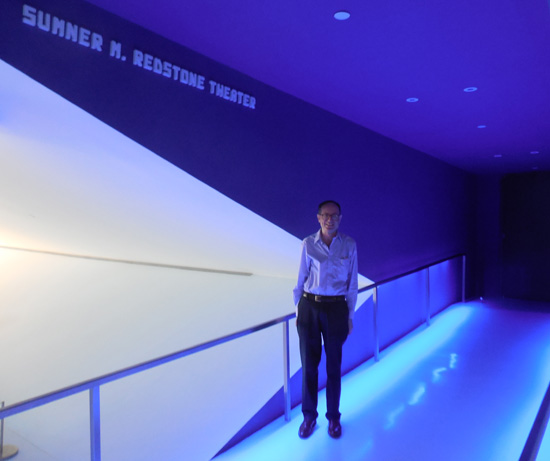 Howard
Haas at the entry to Redstone Auditorium Howard
Haas at the entry to Redstone Auditorium At 7 PM, the Trilogy's final film “The Enchanted Desna” (1964, 2.20 aspect ratio, 82 minutes) was shown, with even more seats filled in the Redstone Auditorium. All three Russian films had brief introductions by a museum curator and by guest curator Max Carpenter who organized them. They told us this was likely the first time in New York that these last two films had been shown in 70mm. “Desna” also had a longer introduction by Jonathan Rosenbaum, who flew in from Chicago to see the films and introduce this one. His 1972 review of the movie was reprinted in the museum's brochure on this trilogy. Jonathan had met the director in London, a rather brief conversation since he didn't speak Russian nor did she speak English. He hailed “Desna” as a masterpiece. The “Desna” print was very good. Sound was very loud (not too loud), also magnetic but not with surround. The cinematography was great, and the World War Two scenes were powerful. “Desna” is not exactly a clear, straight forward story. Afterwards, outside, I overheard an older couple mentioning the one scene that they, and I, liked the best, that of the talking horses! Of the trilogy, had only attended this third film, which they perceived as not having a plot. A “fantasy” film, the writer reminisces in it of his childhood village. My favorite of the trilogy was “Flaming” especially because the WW2 scenes and cinematography were so great in 70mm surround sound on the big screen. Seeing these Russian films on the big screen, including two in 70mm, was definitely a once in a lifetime opportunity, and made for an exciting day! The next day, Sunday, was to be like Saturday, with additional screenings of the Russian Trilogy and of “The Dark Crystal.” The festival was to conclude with the second screening of “The Right Stuff” on Friday, September 1. |
|
| Go: back - top - back issues - news index Updated 22-01-25 |
